A super simple one-pot chicken udon soup that guarantees maximum satisfaction with beautifully seared chicken, rich soup, thick noodles, and tender veggies.
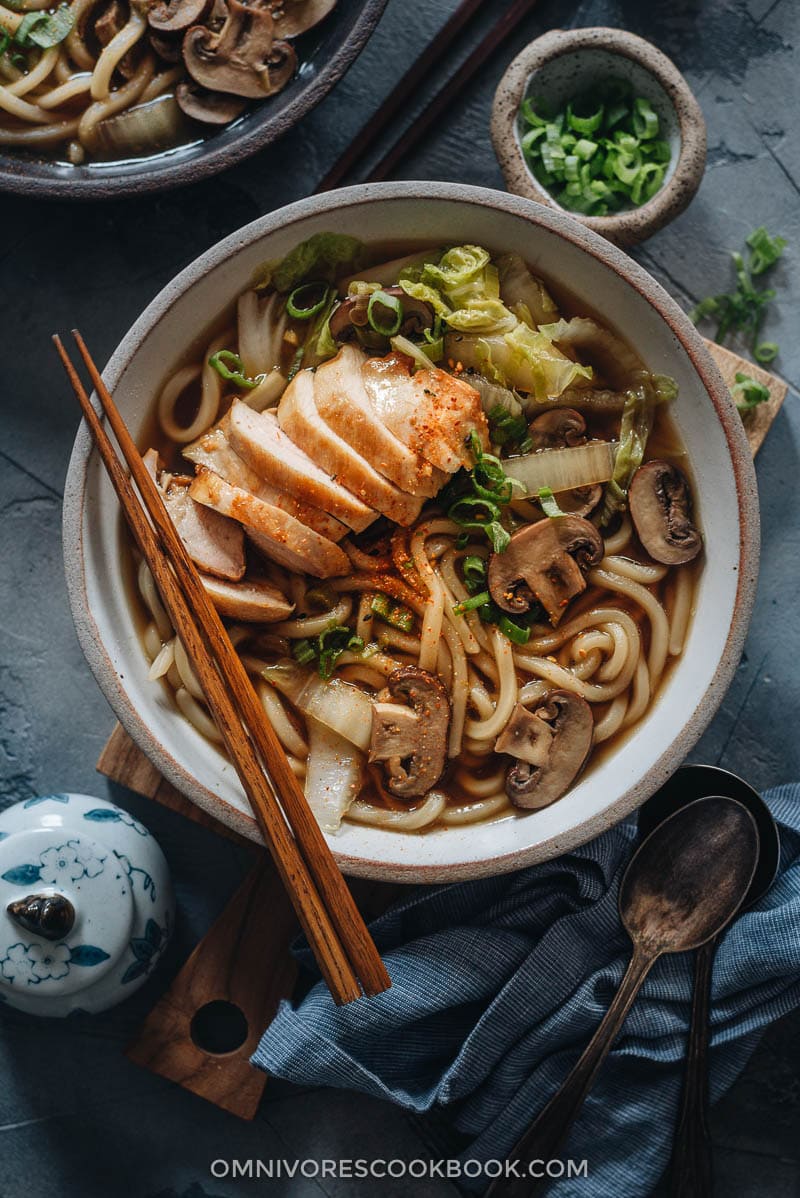
After moving from Austin to New York this March, I came across some difficult situations in my kitchen.
First of all, our apartment didn’t have gas for six months due to a fire that happened on the ground floor. Since both our stove and oven are powered by gas, we basically had to cook with electric devices and a portable stove.
Also, we spent the first month with a tiny kitchen counter that is 14” (35 cm) wide and 24” (60 cm) deep. I can barely fit two cutting boards on it. I had to dry my dishes on the floor because, of course, the kitchen doesn’t have a dishwasher. Welcome to New York! I ended up furnishing the other side of the kitchen with two sets of cabinets from Ikea later on. But before the construction was done, I had to cook on this tiny counter without gas.
It felt like college dorm life all over again.
Luckily, Vermicular came to my rescue. The Vermicular Musui–Kamado is a popular Japanese cooking device that comes with an enameled cast-iron pot with a three-dimensional electric induction heating device. Earlier this year, the company launched this product in the US. I was lucky enough to receive one to test it out. The pot was so convenient that I used it to cook everything I wanted, even before I had unpacked all our kitchen gear. Fried eggs, toast, steamed rice, sauteed veggies, noodle soup, kimchi stew… You name it. Thanks to this magical multi-function cooker, I was able to enjoy hearty and healthy homemade meals during that hectic moving time.

Why this recipe
During the months when we didn’t have gas, I developed many one-pot recipes using my Musui–Kamado because that was the only way to cook dinner without spending hours in the kitchen. One of the recipes I created is this delicious chicken udon soup, which now holds a place in my collection of authentic Chinese soup recipes. Below are the differences between this recipe and most chicken udon soup recipes out there. And why this method makes a better dish.
1. Better chicken
Most chicken udon soup recipes boil the chicken in the soup or use leftover chicken as the topping. It’s a very easy method, but the flavor of the chicken often falls flat.
In my recipe, I used a different approach by searing the chicken and then briefly steam-roasting it in a 3-ingredient sauce. Steam-roasting creates a beautifully browned chicken that is extra rich and flavorful. And by searing the chicken first in the Musui, it leads to the next benefit.

2. Extra rich soup
Once you sear the chicken and steam-roast it in the sauce, it will render delicious juice and some fat into the sauce. Simply add the remaining ingredients into the pot, and your udon soup will come out extra rich. No sauteed aromatics or sesame oil required. In fact, the result is so good that most of the time I actually use vegetable broth instead of chicken broth to make my meal slightly healthier. The hint of sweetness from the veggie broth adds a nice touch to the dish, and the dark color makes the soup look more appetizing.
3. Easy ingredients
Traditional Japanese udon usually uses dashi broth made by slowly simmering seaweed and dried fish flakes (katsuobushi). Although you can use store-bought dashi or dashi powder, you may not have that on hand. Using the method and simple sauce in this recipe, you can skip this special ingredient and still get a great result.
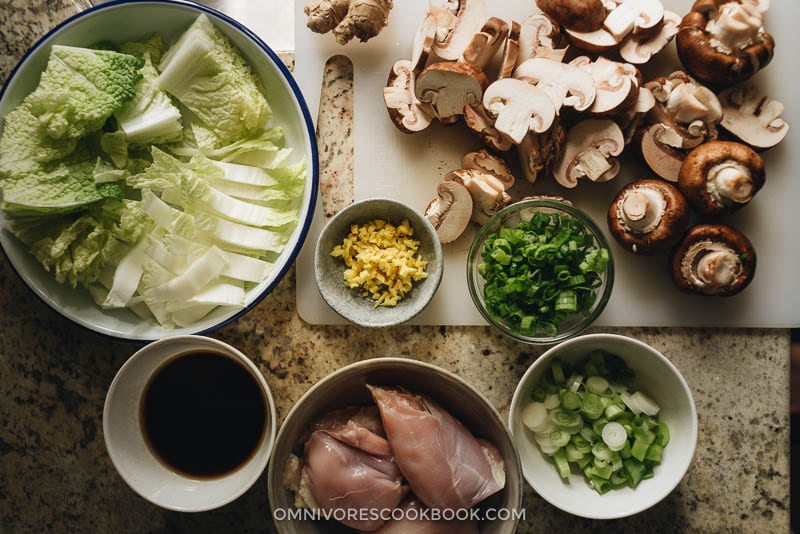
Cooking notes
1. Cut of chicken
Although you can use chicken breast in this recipe, I highly recommend using chicken thighs. Dark meat will release much more umami into the broth and make the soup taste better. Alternatively, you can use bone-in skin-on thighs if you like crispy chicken skin. Make sure you place them skin-side-up once you sear the chicken, and only add the sauce around the chicken, not on top of it, without touching the skin. If you end up using chicken breast or bone-in thighs, adjust the cooking time accordingly since both cuts take longer to cook through.
2. The types of noodles to use
I always prefer to use extra-thick udon noodles in this dish. This type of udon noodle is sold pre-cooked and frozen. You simply need to throw them into the soup and they will be ready once heated through. I really love the fact that you don’t need to boil another pot of water to cook the noodles.
If dried udon is the only product you have access to, you can use it instead. Please note, the noodles will come out quite narrow and flat. And they will look different from the dish shown in the pictures here and they’ll have a different texture.
3. A word on Japanese sake
I always use the combination of Japanese sake and sugar to replace mirin in all of my Japanese recipes. For me, mirin tastes just like that combination, only with slightly lower quality and a sweeter taste. That being said, if you only have mirin on hand, you can use 2 tablespoons of mirin to replace the sake and sugar in the recipe. Alternatively, you can replace the sake with 2 tablespoons of dry sherry or Shaoxing wine.
4. How to cut napa cabbage
To evenly cook napa cabbage, the best way is to separate the white thick part from the green part and cook them for different lengths of time.
To cut napa cabbage:
- Slice crosswise to separate the white and green parts.
- Slice the white part into strips.
- Slice the green part into bite-size pieces that are larger than the pieces of white part. The green part will shrink a lot once cooked, so you should make those pieces larger.
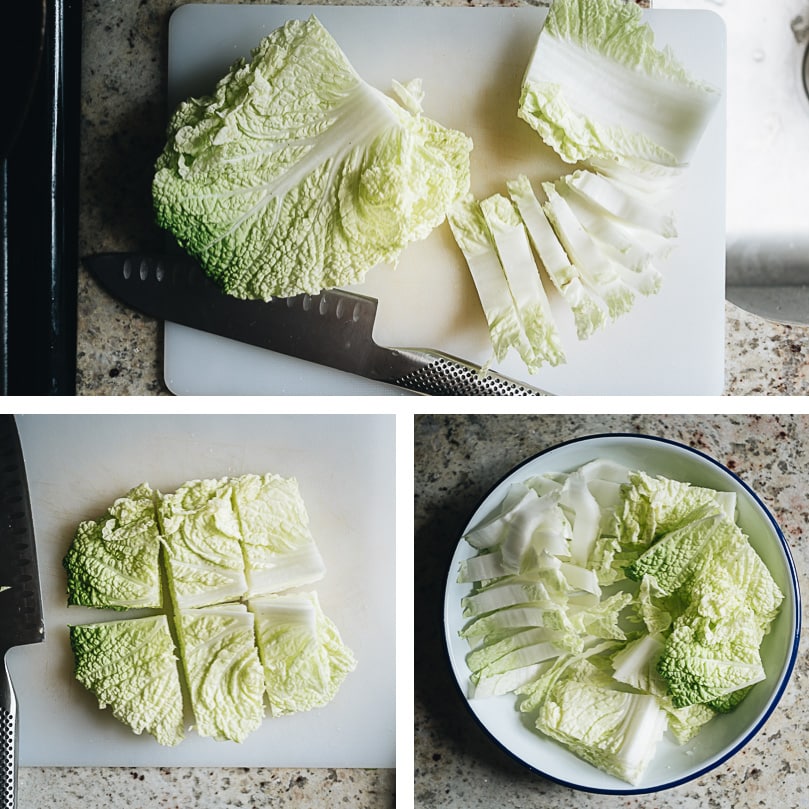
5. Cook with a regular pot
I made this dish using the Vermicular Musui–Kamado. But you can use a dutch oven or heavy-duty pot on the stovetop for this recipe as well.
A word on the cookware
The gas in our apartment finally came back this month. However, our frequent use of the Vermicular Musui–Kamado continues.
Different from setting a cast iron pot on a flat electric stove, the Musui–Kamado uses its three-dimensional induction heating base, the Kamado, that heats up quickly, evenly, and with precision temperature control. I love the fact that when I cook a large pot of stew or soup, I can leave it cooking without needing to stir it all the time to ensure even cooking.
The Musui enameled cast-iron pot comes with a lid that features a precision tight-fit seal, engineered to draw out the umami of the ingredients. Sometimes when we’re lazy but want healthy homemade food, we simply throw a bunch of chopped veggies such as cauliflower and broccoli into the pot and add a drizzle of broth and a pinch of spices. The veggies come out lightly browned on the bottom, tender in texture, and with a lovely sweet flavor.
I would recommend Vermicular’s Musui–Kamado to anyone who is a serious cook or needs a single cooking device to simplify their life. It has a rice cooking function (including brown rice and porridge/congee) built in, so it effectively doubles as a rice cooker. The device also has low-temperature setting (Extra Low) to be used as a slow cooker. Finally, it has a [WARM] mode. In addition to keeping foods warm, the [WARM] mode also allows controlled ultra-low temperature (below boiling) cooking. This way you can ferment or precision cook (like sous vide, by filling the Musui with water, setting it to a specific temperature and then placing your vacuum-sealed ingredients into the pot to gently cook.) So if you wanted to make your own miso or sous-vide steak at home, the Musui–Kamado would make it very easy for you.
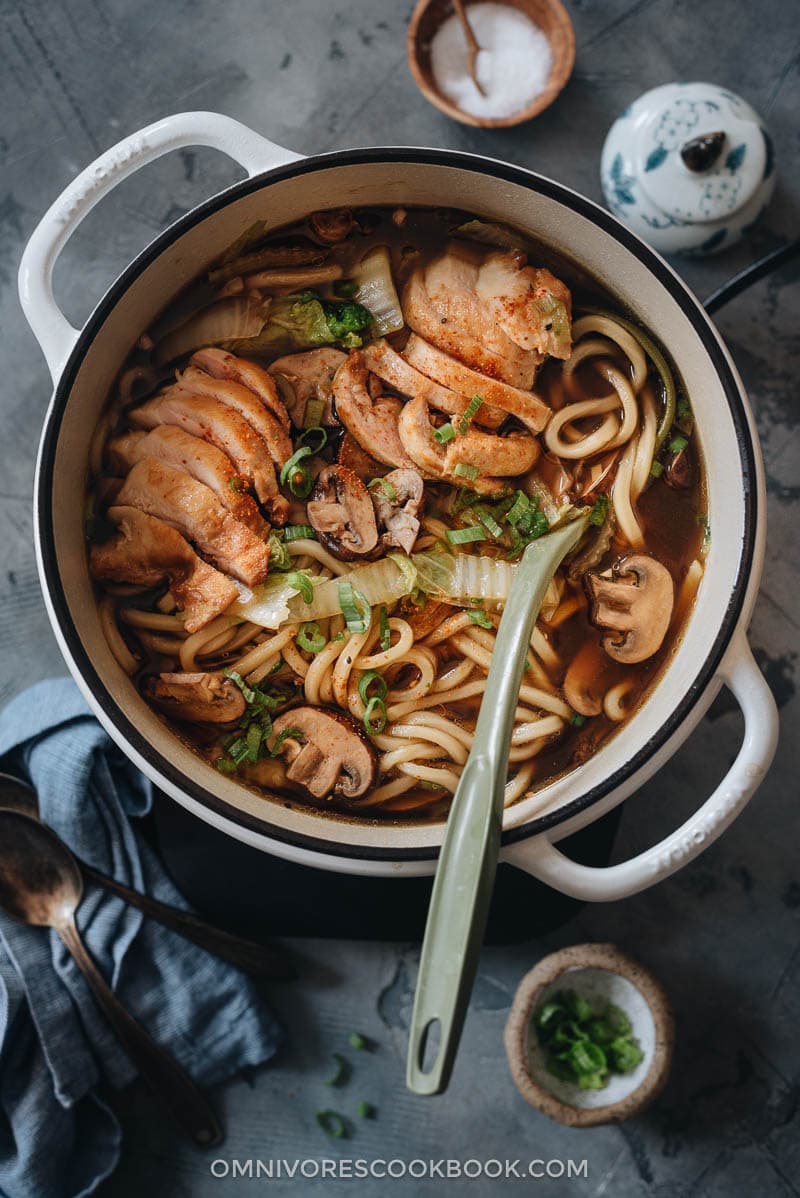
Afterthoughts
The weather is still plenty hot and I try to spend as little time in the kitchen as possible. But because of my Asian habits, I can’t help craving a bowl of noodle soup at any time of year. And this chicken udon soup is perfect on such an occasion. Because it’s so easy and fast to make. I hope you enjoy the dish!
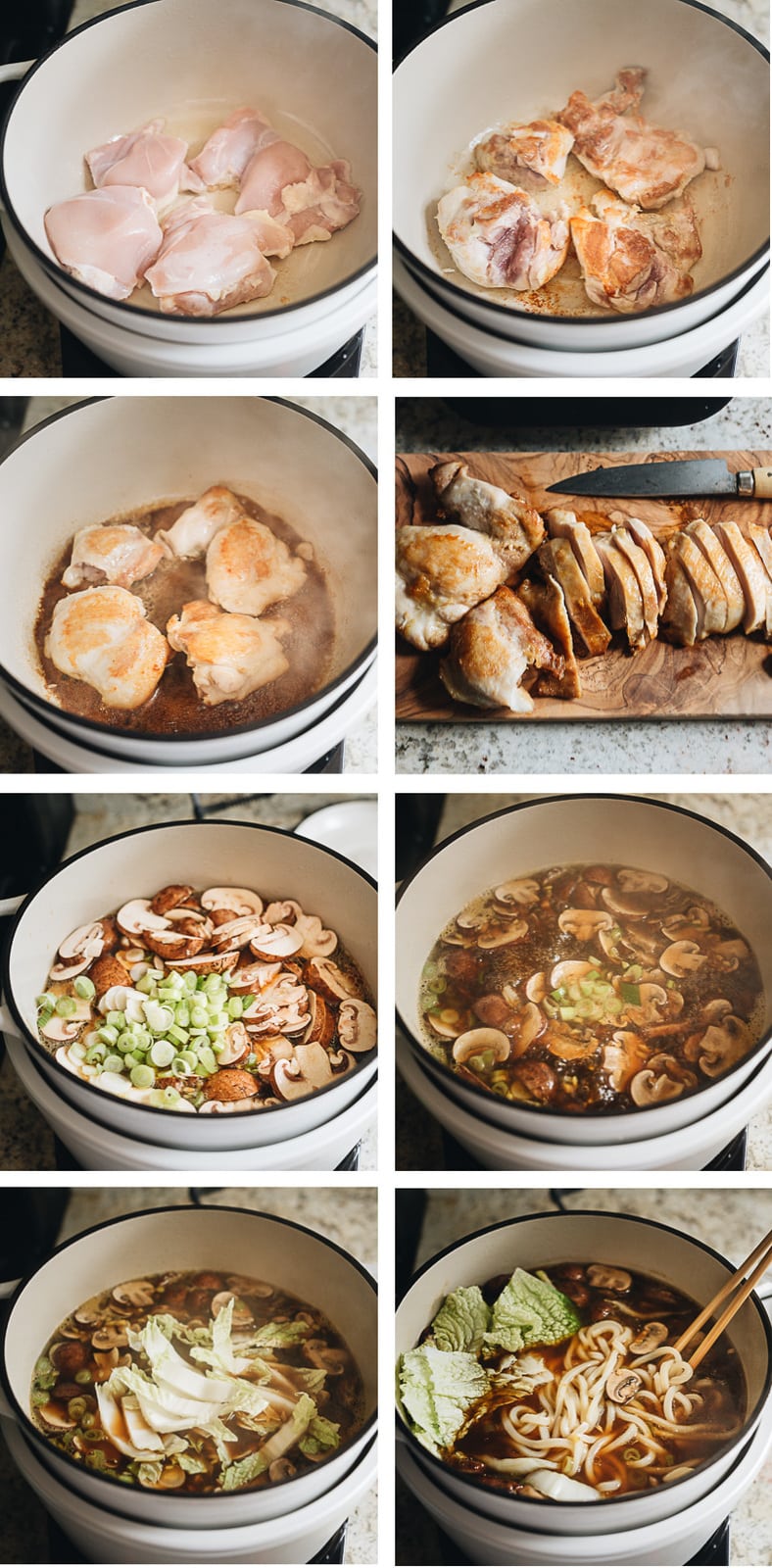

More delicious one-pot recipes
- Korean Army Stew (Budae Jjigae)
- Thai Peanut Butter Ramen
- Easy Fried Udon (Yaki Udon)
- Easy Pineapple Fried Rice
- Easy Singapore Noodles
If you give this recipe a try, let us know! Leave a comment, rate it (once you’ve tried it), and take a picture and tag it @omnivorescookbook on Instagram! I’d love to see what you come up with.
Chinese Cooking Made Easy
Are you new to this website? This free email series is a great place to start. I’ll walk you through a few of my most popular recipes and show you how and why they work. You’ll quickly start to cook better Chinese food in your own kitchen.
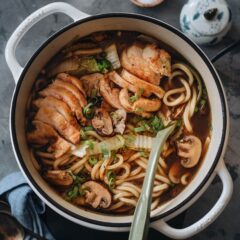
Chicken Udon Soup (鸡肉乌冬面)
The recipe yields 2 big servings as a main or 4 small servings as a side.
I made this dish using the Vermicular Musui–Kamado. But you can use a dutch oven or heavy-duty pot for this recipe instead.
Ingredients
- 1 tablespoon peanut oil (or vegetable oil)
- 1 lb boneless skinless chicken thigh (or breast)
Sauce
- 3 tablespoons Japanese sake (or 2 tablespoons dry sherry)
- 3 tablespoons soy sauce
- 2 teaspoons sugar
Soup
- 4 cups chicken broth (or vegetable broth)
- 1/2 lb brown mushrooms , sliced (or 8 fresh shiitake mushrooms)
- 3 green onions , sliced, green and white parts separated
- 1 tablespoon ginger , minced
- 4 cups napa cabbage , chopped
- 2 packs udon noodles (total 17-oz / 500 g) , frozen (or dried udon noodle) (*Footnote 1)
Instructions
- Add the oil into the Vermicular Musui–Kamado (or a 4-quart dutch oven). Turn to medium heat setting. Let it heat up until it shows “Grill OK”.
- Mix the sauce in a small bowl while heating up the pot.
- Add the chicken thighs into the pot without overlapping. Sear until the bottom turns golden brown, 2 to 3 minutes. Flip and sear the other side.
- Once both sides of the chicken are seared, pour the sauce into the pot. Turn to low heat. Cover and let it cook until the chicken thighs are cooked through, 5 minutes or so. Once done, transfer the chicken to a big plate.
- Add the broth, mushrooms, white part of the green onion, and ginger. Turn the heat setting to medium. Cover and cook until the mushrooms are cooked through, about 10 minutes.
- Add the white part of the napa cabbage and cover again. Cook for 3 minutes.
- Add the noodles, the green part of the cabbage, and the green part of the green onions. Cook until the noodles heat up and the cabbage turns tender, about 2 minutes. Turn off the heat.
- Slice the cooked chicken and place it on top of the noodles.
- Serve hot as a main dish.
Notes
- If you use dried udon noodles, you’ll need to cook them according to the instructions on the package in separate pot before adding them to the broth. In this case, add the noodles at the end of the cooking once everything else is ready.
Nutrition

Did you make this recipe?
I’d love to hear how it turned out for you! Please take a moment to leave a 5-star rating ⭐️ and share your thoughts in the comments further down the page. It really helps others discover the recipe too.

Texaboose
My go-to udon recipe. Quick and easy to make for lunches and healthy as well.
Kat
My family loves this udon recipe.
Steve
This was a good soup base, but far too salty with store bought stock. I had to water the final product down to make it edible.
SPARKSOFEMBER
Just wanted to say I made this again, this time 100% following the recipe (except I used 4 packs of udon noodles). We had it for Christmas eve dinner with my entire family visiting, and it was a huge hit. Hubby says he prefered the lipton soup mix vs the vegetable broth but I liked the broth slightly better. But both are great!
SparksofEmber
Very yummy & flexible recipe!
Normally, I hate deviating too much from a recipe, but I decided to make this on a whim to use up some old frozen udon noodles and we didn’t have mushrooms, napa cabbage, or green onions so I substituted carrots and frozen peas instead. I also discovered while cooking the chicken that I was out of my favorite Better than Bouillon Vegetable Base. In fact the only thing I had to make any kind of last-minute broth was Lipton Onion soup powder. But it still turned out fantastic – there were no leftovers (which never happens in my home) and my husband said it was the best soup I’ve ever made. Next time, I torn over following the recipe more closely or sticking with the odd variation my husband loved. lol
Lou Champion
this is a great easy and tasty recipe. thanks for sharing
Patty
Just finished my first attempt and taste great. I cant wait to eat lunch tomorrow. Yumm
Mark Volker
This recipe was amazing. I changed up my chicken though. I want more spice so I marinated the chicken in a garlic chili sauce with brown sugar and oil. Everything else I did to your directions.
Noelle
Can you use mirin to replace sake?
Maggie Zhu
You can, but you will need to reduce the sugar to 1 teaspoon or less (add it at the end and taste the soup to adjust it), so the soup won’t be overly sweet.
Jay Hollingsworth
I have dried dashi and can make the broth. How would I add this to this recipe. My wife and I are excited about trying this recipe? Thank you for sharing!
Maggie
Hi Jay, this noodle soup will come out very rich and flavorful without the dashi. That being said, you can totally add the dried dashi to make the broth more authentic. I would start with adding 1/2 teaspoon of the dried dashi and reduce 1 tablespoon soy sauce. Then you can adjust the taste by adding more dashi (to increase the seafood flavor) or a bit more soy sauce.
Melissa
This was really delicious and comforting. Great flavor, thank you!
Janelle S
This recipe was a hit at my house. I loved how quick the prep was. I modified the recipe slightly with thinly sliced carrots and brocolini instead of Napa cabbage because it was what I had on hand. Delicious!
Joanne Wong
Hi Omnivorescook,
I follow your recipe to made homemade chicken stock, so I am going to use the chicken stock for this recipe. You didn’t state how much water should I add after putting 4 cups of the homemade chicken stock. Do advise
Maggie
Hi Joanne, it really depends on how long you reduced the chicken broth. Sometimes for storage purpose, I reduce the stock a lot until they form a very small bowl of thick gelatin. In that case I use a scoop of the reduced stock with water to create the broth according to my taste. If your stock tastes good as it is, you don’t need to add extra water to it.
Liz
Hello Maggie, is there a non-alcoholic alternate ingredient for the Japanese sake?
LISA GINGERICH
Just had this for dinner tonight and my whole family ate it up! My husband said to do whatever I need to do to keep this recipe. I made a few substitutions, added thin sliced carrot, used shallot not green onion, green cabbage not nappa and maitake mushrooms not brown (as this is what I had on hand) Will definitely be making this again! Thank you!
Sarah
I’m hoping to make this tonight. Could sub baby Bok Choy for the cabbage?…I have that in my fridge already.
Maggie
For sure! They take about the same cooking time. Happy cooking and hope you enjoy the dish!
Sarah
Thank you!
C. Shep
I just came back from a few weeks in Japan and I was hankering for a good Udon recipe. Well, this was it. So delicious! I used store bought stock and thought for sure I was compromising the dish, but the other ingredients deepened the flavor and added complexity. I will add this to my staples. Oh, and frozen Udon worked great too. So yummy.
anne
this japanese c ooking devise—–
is it electrical do i need an electrical outlet
Maggie
Hi Anna, the heating element of the cookware is electrical and you need an outlet to plug it in. But the cast iron pot that sits inside of the heating element can be taken out and used on the stove like a regular pot.